tow FORD C MAX 2008 1.G User Guide
[x] Cancel search | Manufacturer: FORD, Model Year: 2008, Model line: C MAX, Model: FORD C MAX 2008 1.GPages: 278, PDF Size: 17.5 MB
Page 66 of 278
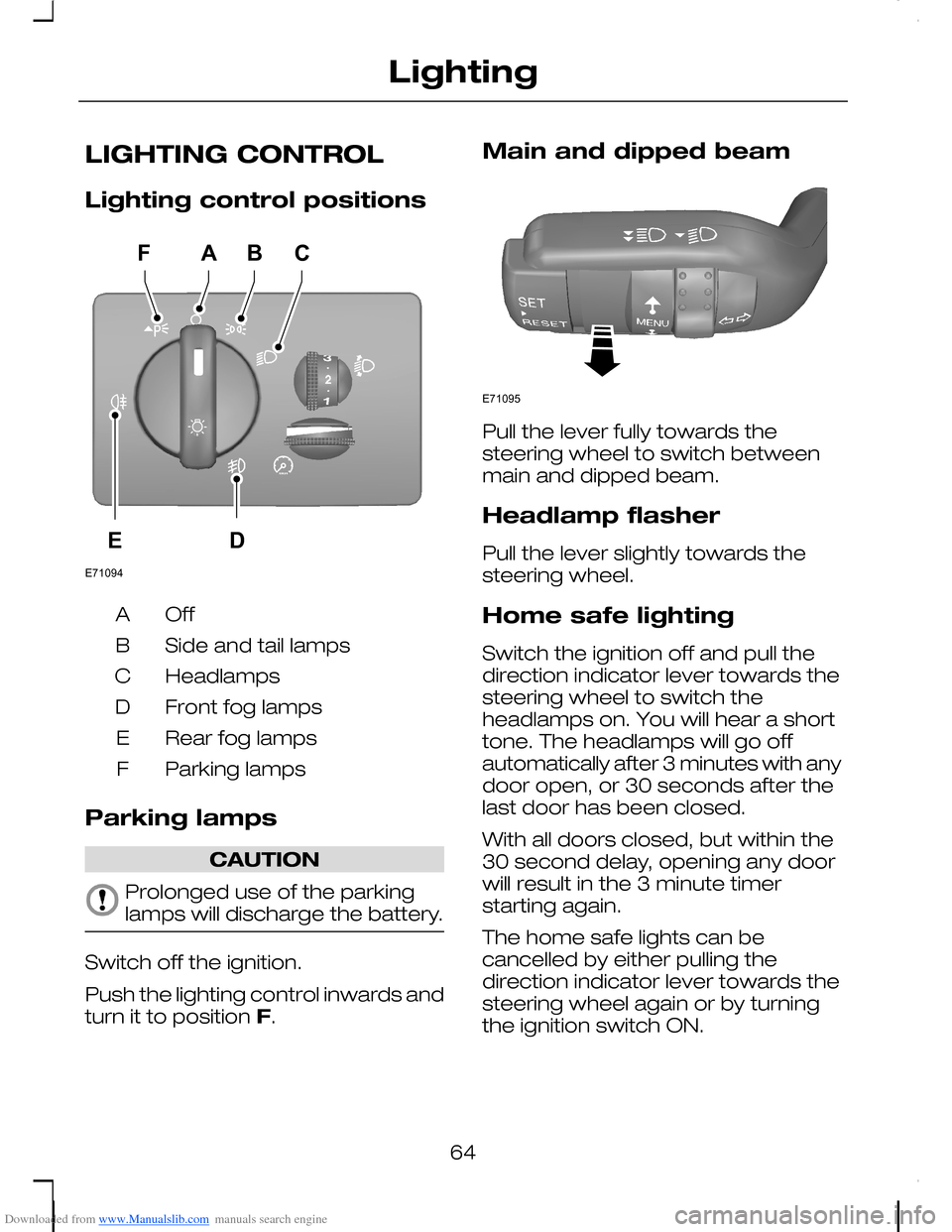
Downloaded from www.Manualslib.com manuals search engine LIGHTING CONTROL
Lighting control positions
OffA
Side and tail lampsB
HeadlampsC
Front fog lampsD
Rear fog lampsE
Parking lampsF
Parking lamps
CAUTION
Prolonged use of the parkinglamps will discharge the battery.
Switch off the ignition.
Push the lighting control inwards andturn it to position F.
Main and dipped beam
Pull the lever fully towards thesteering wheel to switch betweenmain and dipped beam.
Headlamp flasher
Pull the lever slightly towards thesteering wheel.
Home safe lighting
Switch the ignition off and pull thedirection indicator lever towards thesteering wheel to switch theheadlamps on. You will hear a shorttone. The headlamps will go offautomatically after 3 minutes with anydoor open, or 30 seconds after thelast door has been closed.
With all doors closed, but within the30 second delay, opening any doorwill result in the 3 minute timerstarting again.
The home safe lights can becancelled by either pulling thedirection indicator lever towards thesteering wheel again or by turningthe ignition switch ON.
64
LightingE71094DBCAFE E71095
Page 69 of 278
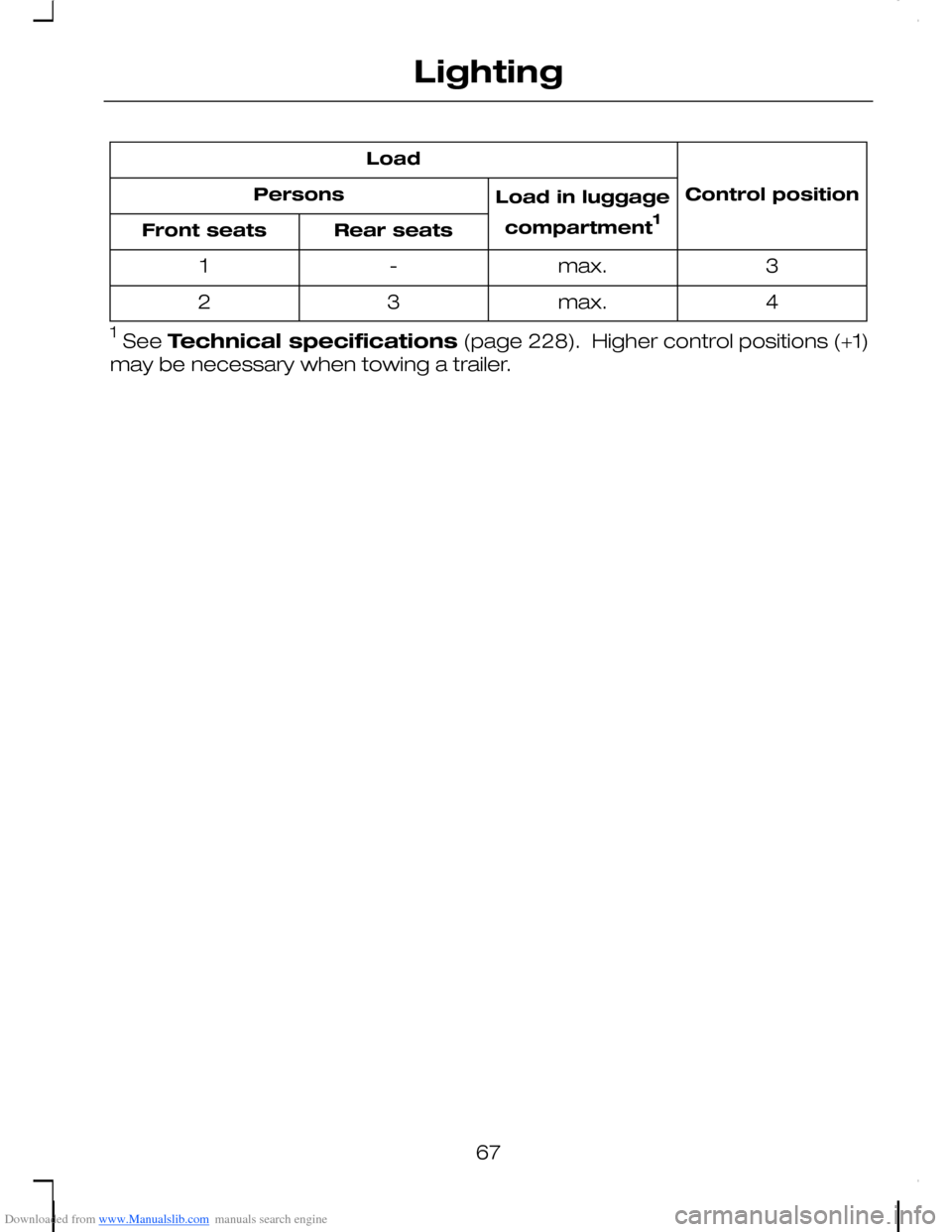
Downloaded from www.Manualslib.com manuals search engine Control position
Load
Load in luggage
compartment1
Persons
Rear seatsFront seats
3max.-1
4max.32
1 See Technical specifications (page 228). Higher control positions (+1)
may be necessary when towing a trailer.
67
Lighting
Page 70 of 278
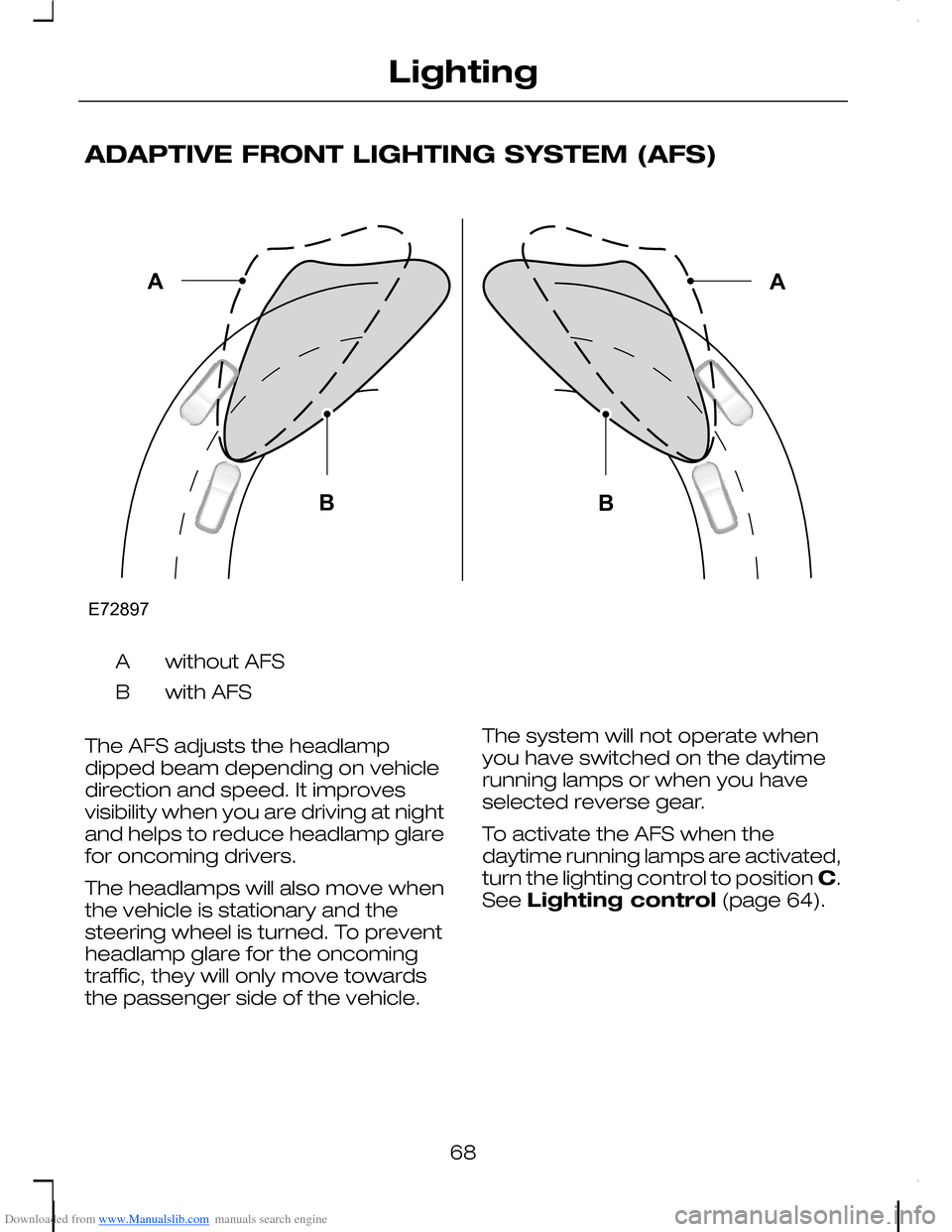
Downloaded from www.Manualslib.com manuals search engine ADAPTIVE FRONT LIGHTING SYSTEM (AFS)
without AFSA
with AFSB
The AFS adjusts the headlampdipped beam depending on vehicledirection and speed. It improvesvisibility when you are driving at nightand helps to reduce headlamp glarefor oncoming drivers.
The headlamps will also move whenthe vehicle is stationary and thesteering wheel is turned. To preventheadlamp glare for the oncomingtraffic, they will only move towardsthe passenger side of the vehicle.
The system will not operate whenyou have switched on the daytimerunning lamps or when you haveselected reverse gear.
To activate the AFS when thedaytime running lamps are activated,turn the lighting control to position C.See Lighting control (page 64).
68
LightingE72897ABAB
Page 109 of 278
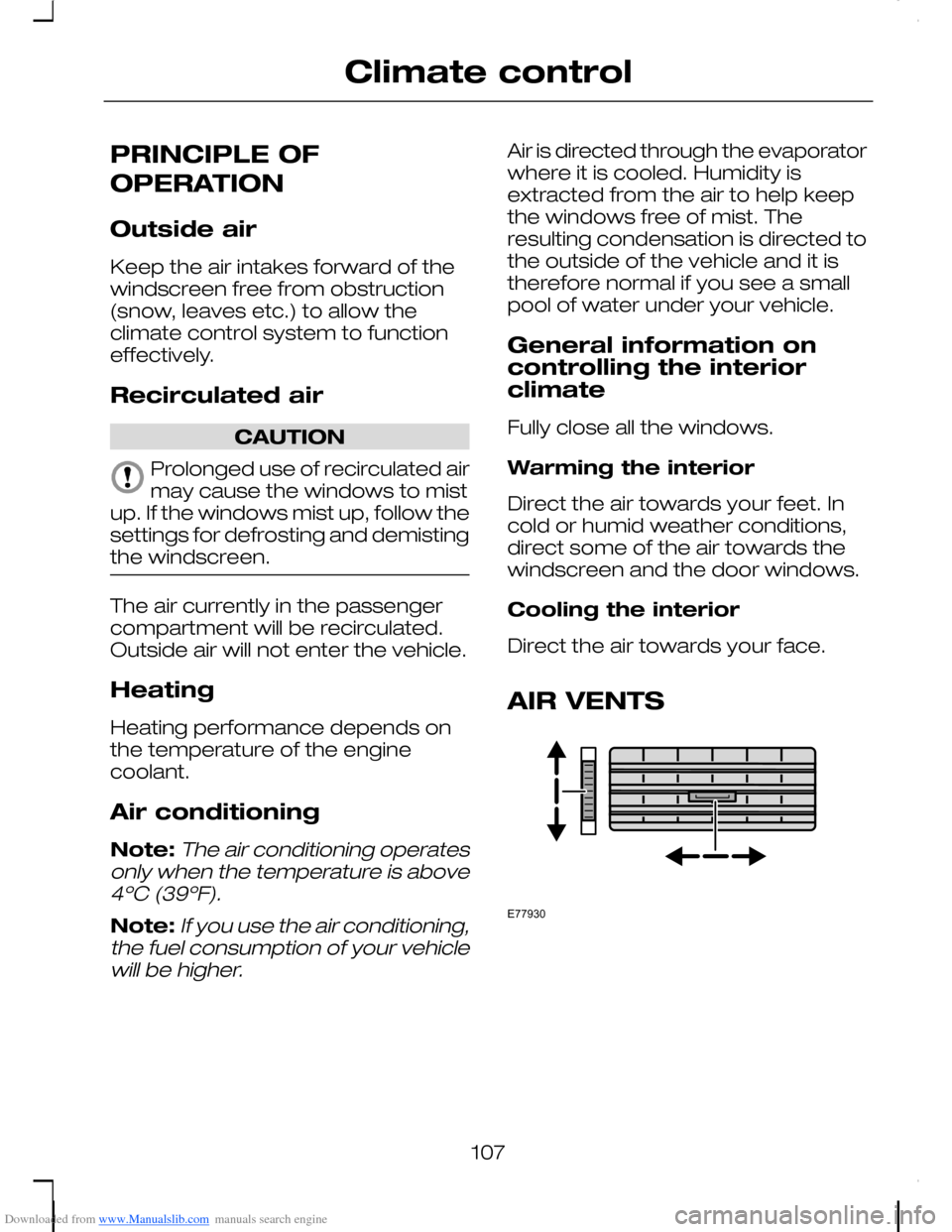
Downloaded from www.Manualslib.com manuals search engine PRINCIPLE OF
OPERATION
Outside air
Keep the air intakes forward of thewindscreen free from obstruction(snow, leaves etc.) to allow theclimate control system to functioneffectively.
Recirculated air
CAUTION
Prolonged use of recirculated airmay cause the windows to mistup. If the windows mist up, follow thesettings for defrosting and demistingthe windscreen.
The air currently in the passengercompartment will be recirculated.Outside air will not enter the vehicle.
Heating
Heating performance depends onthe temperature of the enginecoolant.
Air conditioning
Note:The air conditioning operatesonly when the temperature is above4ºC (39ºF).
Note:If you use the air conditioning,the fuel consumption of your vehiclewill be higher.
Air is directed through the evaporatorwhere it is cooled. Humidity isextracted from the air to help keepthe windows free of mist. Theresulting condensation is directed tothe outside of the vehicle and it istherefore normal if you see a smallpool of water under your vehicle.
General information oncontrolling the interiorclimate
Fully close all the windows.
Warming the interior
Direct the air towards your feet. Incold or humid weather conditions,direct some of the air towards thewindscreen and the door windows.
Cooling the interior
Direct the air towards your face.
AIR VENTS
107
Climate controlE77930
Page 110 of 278
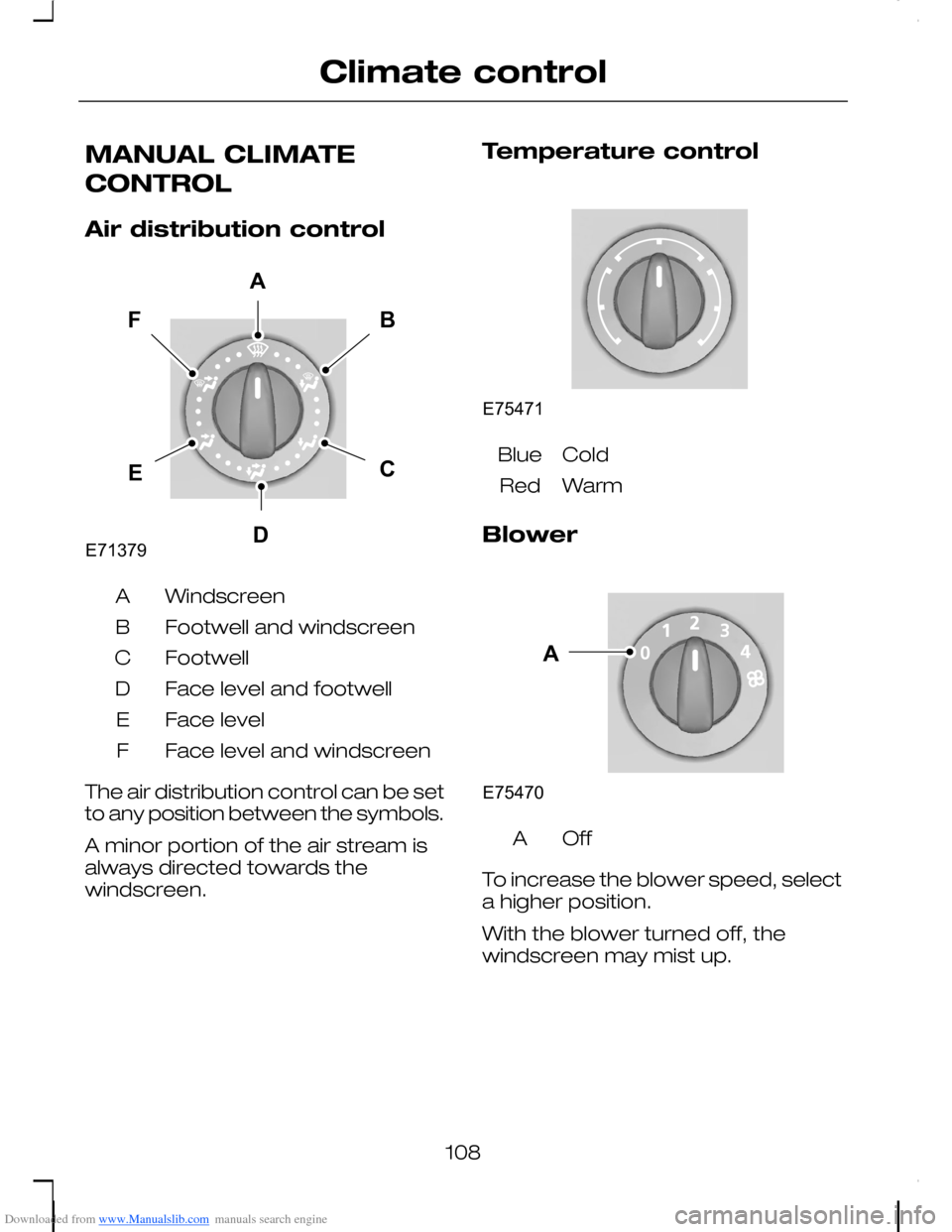
Downloaded from www.Manualslib.com manuals search engine MANUAL CLIMATE
CONTROL
Air distribution control
WindscreenA
Footwell and windscreenB
FootwellC
Face level and footwellD
Face levelE
Face level and windscreenF
The air distribution control can be setto any position between the symbols.
A minor portion of the air stream isalways directed towards thewindscreen.
Temperature control
ColdBlue
WarmRed
Blower
OffA
To increase the blower speed, selecta higher position.
With the blower turned off, thewindscreen may mist up.
108
Climate controlE71379AFBCDE E75471 AE75470
Page 112 of 278
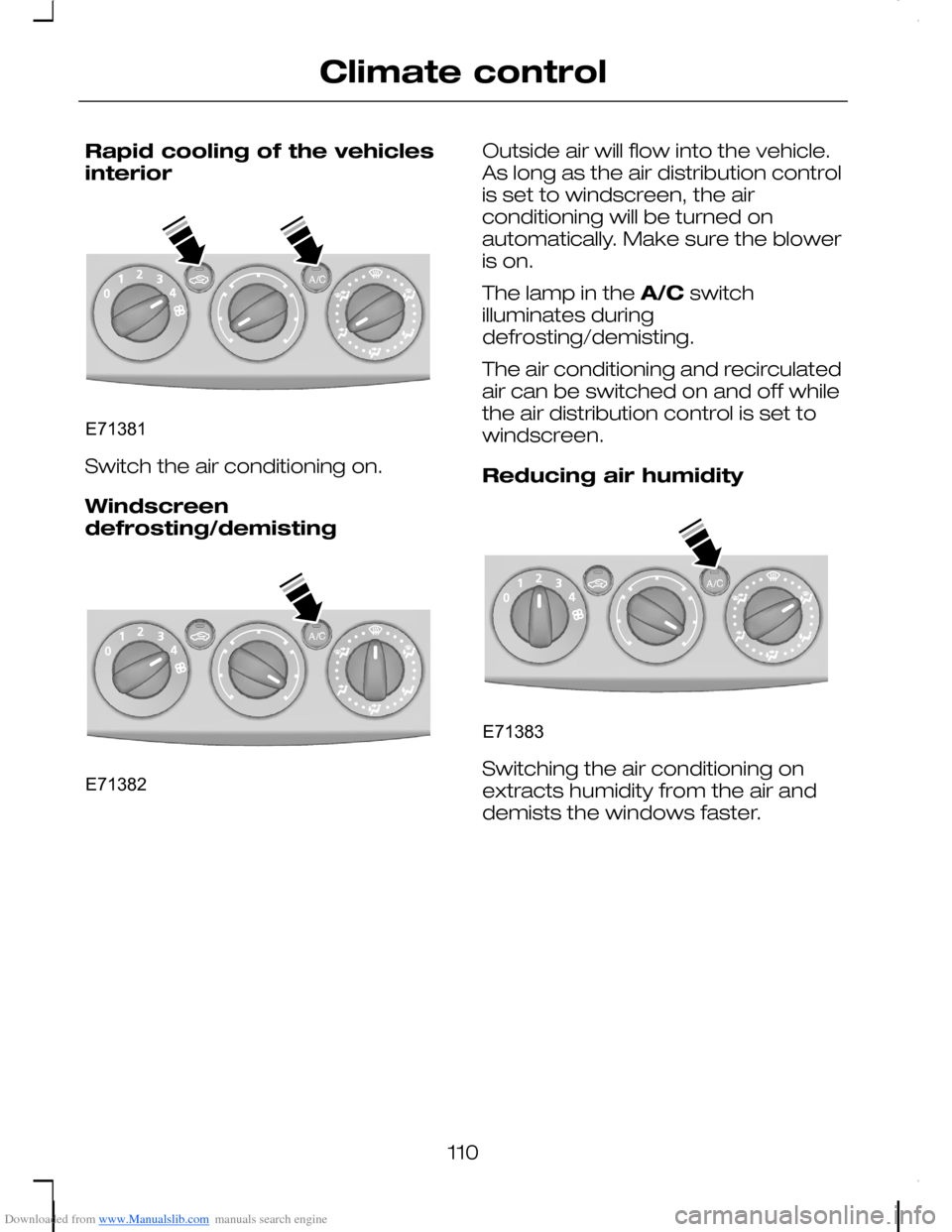
Downloaded from www.Manualslib.com manuals search engine Rapid cooling of the vehiclesinterior
Switch the air conditioning on.
Windscreendefrosting/demisting
Outside air will flow into the vehicle.As long as the air distribution controlis set to windscreen, the airconditioning will be turned onautomatically. Make sure the bloweris on.
The lamp in the A/C switchilluminates duringdefrosting/demisting.
The air conditioning and recirculatedair can be switched on and off whilethe air distribution control is set towindscreen.
Reducing air humidity
Switching the air conditioning onextracts humidity from the air anddemists the windows faster.
110
Climate controlE71381 E71382 E71383
Page 143 of 278
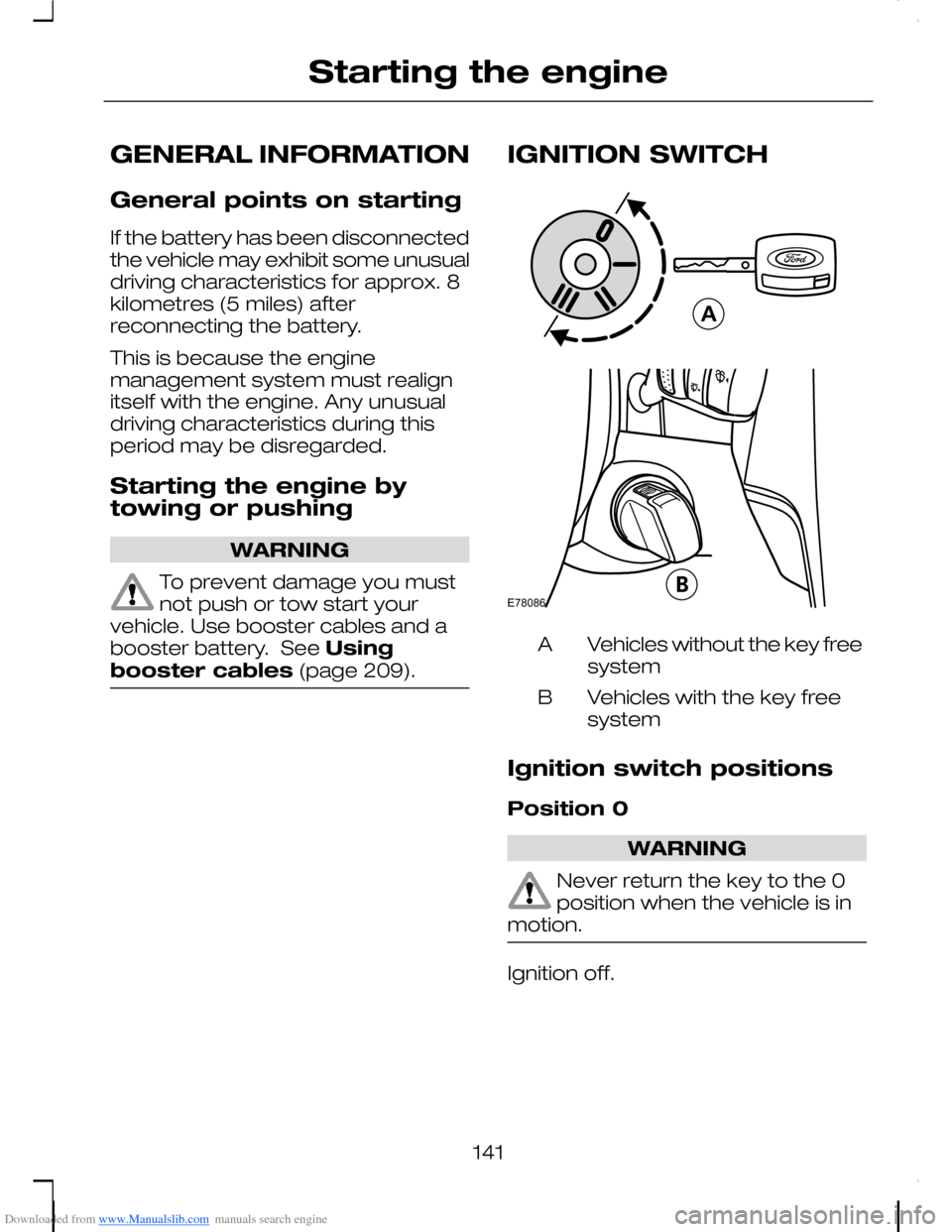
Downloaded from www.Manualslib.com manuals search engine GENERAL INFORMATION
General points on starting
If the battery has been disconnectedthe vehicle may exhibit some unusualdriving characteristics for approx. 8kilometres (5 miles) afterreconnecting the battery.
This is because the enginemanagement system must realignitself with the engine. Any unusualdriving characteristics during thisperiod may be disregarded.
Starting the engine bytowing or pushing
WARNING
To prevent damage you mustnot push or tow start yourvehicle. Use booster cables and abooster battery. See Usingbooster cables (page 209).
IGNITION SWITCH
Vehicles without the key freesystemA
Vehicles with the key freesystemB
Ignition switch positions
Position 0
WARNING
Never return the key to the 0position when the vehicle is inmotion.
Ignition off.
141
Starting the engineE78086
Page 144 of 278
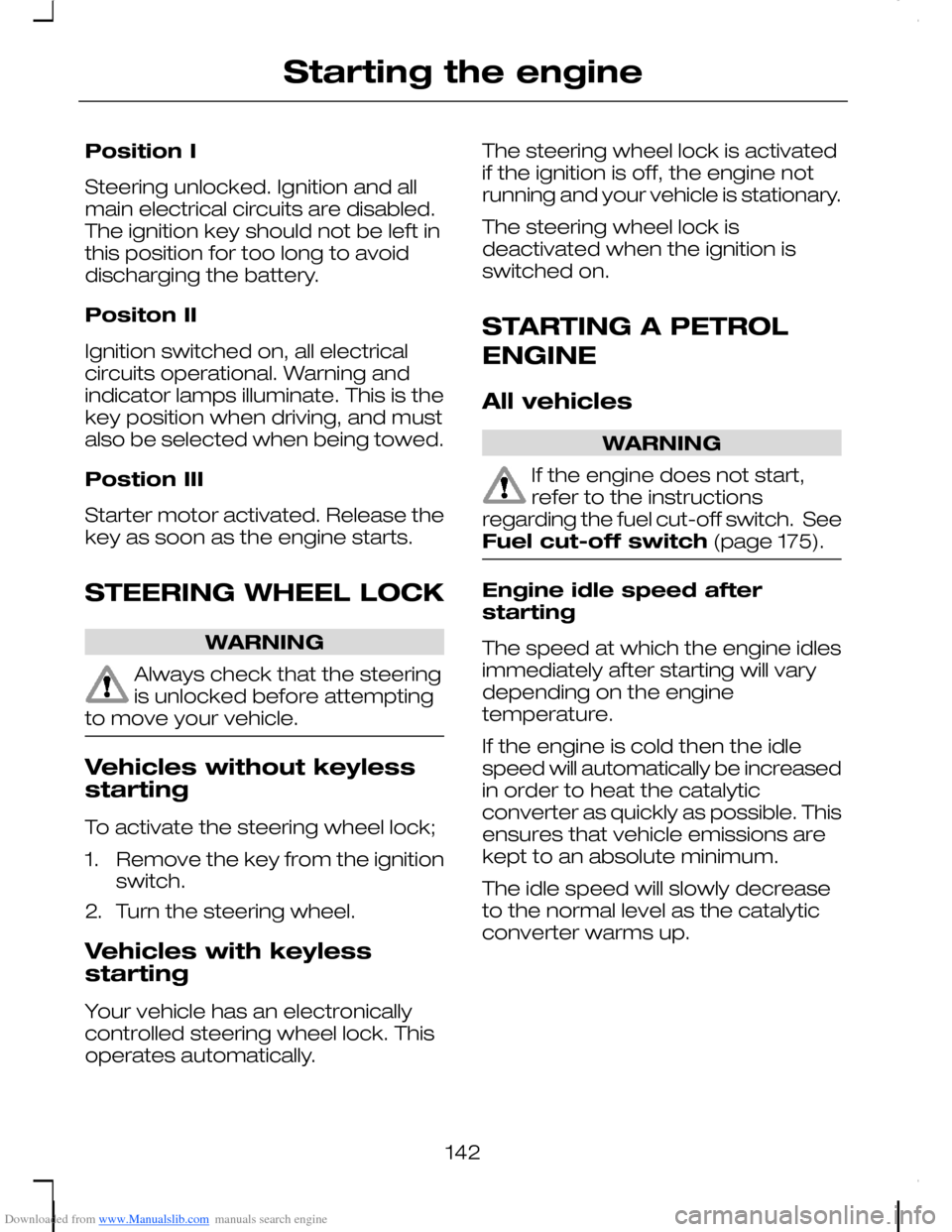
Downloaded from www.Manualslib.com manuals search engine Position I
Steering unlocked. Ignition and allmain electrical circuits are disabled.The ignition key should not be left inthis position for too long to avoiddischarging the battery.
Positon II
Ignition switched on, all electricalcircuits operational. Warning andindicator lamps illuminate. This is thekey position when driving, and mustalso be selected when being towed.
Postion III
Starter motor activated. Release thekey as soon as the engine starts.
STEERING WHEEL LOCK
WARNING
Always check that the steeringis unlocked before attemptingto move your vehicle.
Vehicles without keylessstarting
To activate the steering wheel lock;
1.Remove the key from the ignitionswitch.
2.Turn the steering wheel.
Vehicles with keylessstarting
Your vehicle has an electronicallycontrolled steering wheel lock. Thisoperates automatically.
The steering wheel lock is activatedif the ignition is off, the engine notrunning and your vehicle is stationary.
The steering wheel lock isdeactivated when the ignition isswitched on.
STARTING A PETROL
ENGINE
All vehicles
WARNING
If the engine does not start,refer to the instructionsregarding the fuel cut-off switch. SeeFuel cut-off switch (page 175).
Engine idle speed afterstarting
The speed at which the engine idlesimmediately after starting will varydepending on the enginetemperature.
If the engine is cold then the idlespeed will automatically be increasedin order to heat the catalyticconverter as quickly as possible. Thisensures that vehicle emissions arekept to an absolute minimum.
The idle speed will slowly decreaseto the normal level as the catalyticconverter warms up.
142
Starting the engine
Page 152 of 278
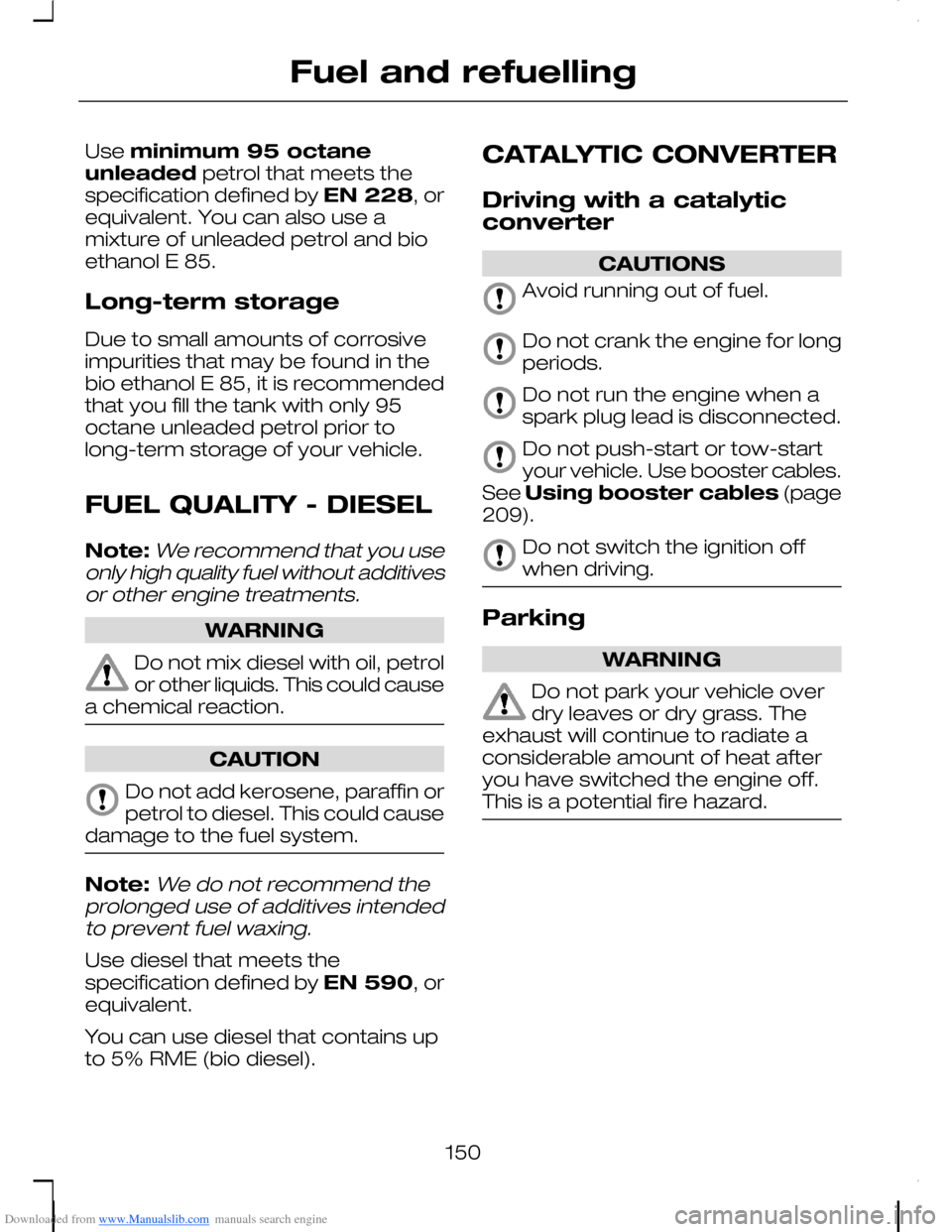
Downloaded from www.Manualslib.com manuals search engine Use minimum 95 octaneunleaded petrol that meets thespecification defined by EN 228, orequivalent. You can also use amixture of unleaded petrol and bioethanol E 85.
Long-term storage
Due to small amounts of corrosiveimpurities that may be found in thebio ethanol E 85, it is recommendedthat you fill the tank with only 95octane unleaded petrol prior tolong-term storage of your vehicle.
FUEL QUALITY - DIESEL
Note:We recommend that you useonly high quality fuel without additivesor other engine treatments.
WARNING
Do not mix diesel with oil, petrolor other liquids. This could causea chemical reaction.
CAUTION
Do not add kerosene, paraffin orpetrol to diesel. This could causedamage to the fuel system.
Note:We do not recommend theprolonged use of additives intendedto prevent fuel waxing.
Use diesel that meets thespecification defined by EN 590, orequivalent.
You can use diesel that contains upto 5% RME (bio diesel).
CATALYTIC CONVERTER
Driving with a catalyticconverter
CAUTIONS
Avoid running out of fuel.
Do not crank the engine for longperiods.
Do not run the engine when aspark plug lead is disconnected.
Do not push-start or tow-startyour vehicle. Use booster cables.See Using booster cables (page209).
Do not switch the ignition offwhen driving.
Parking
WARNING
Do not park your vehicle overdry leaves or dry grass. Theexhaust will continue to radiate aconsiderable amount of heat afteryou have switched the engine off.This is a potential fire hazard.
150
Fuel and refuelling
Page 153 of 278
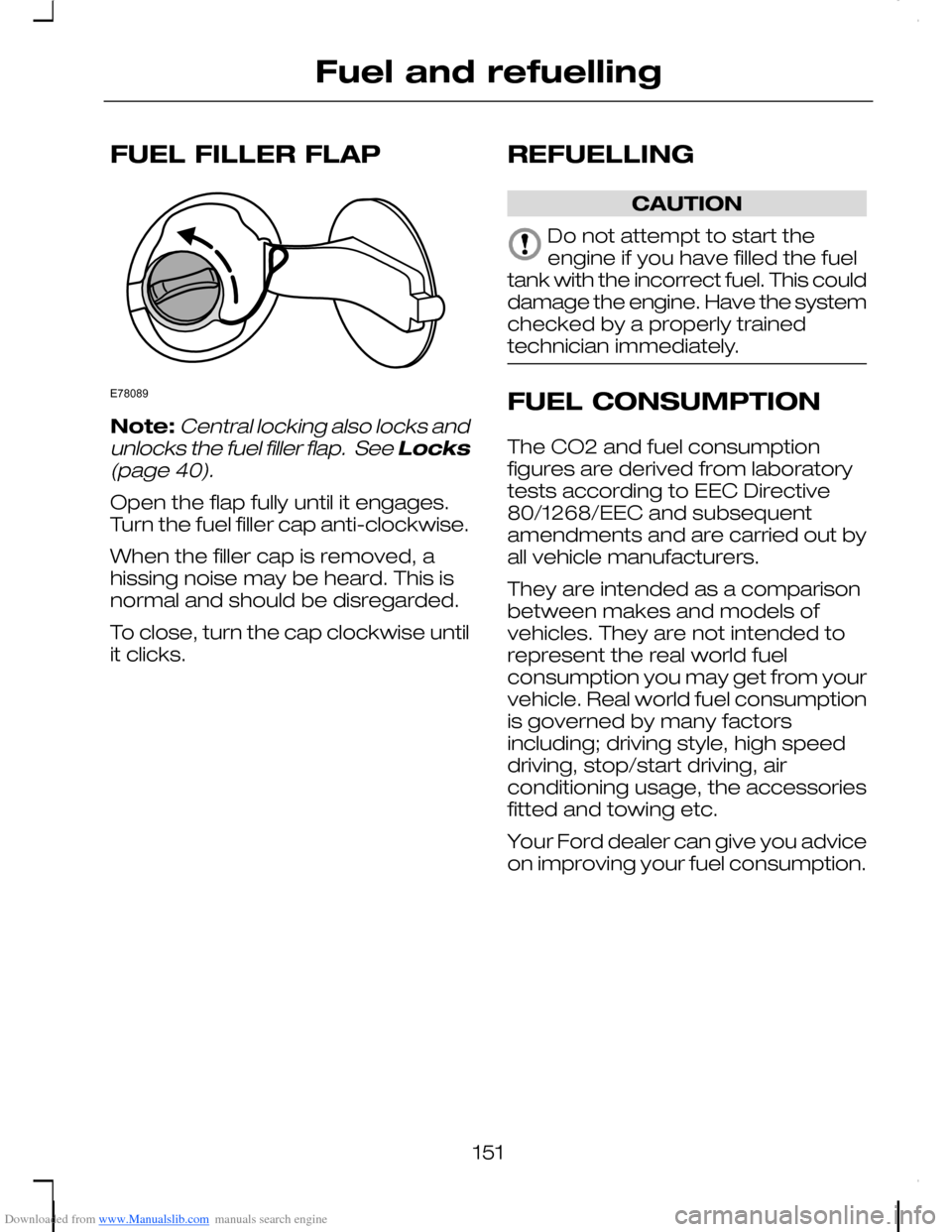
Downloaded from www.Manualslib.com manuals search engine FUEL FILLER FLAP
Note:Central locking also locks andunlocks the fuel filler flap. See Locks(page 40).
Open the flap fully until it engages.Turn the fuel filler cap anti-clockwise.
When the filler cap is removed, ahissing noise may be heard. This isnormal and should be disregarded.
To close, turn the cap clockwise untilit clicks.
REFUELLING
CAUTION
Do not attempt to start theengine if you have filled the fueltank with the incorrect fuel. This coulddamage the engine. Have the systemchecked by a properly trainedtechnician immediately.
FUEL CONSUMPTION
The CO2 and fuel consumptionfigures are derived from laboratorytests according to EEC Directive80/1268/EEC and subsequentamendments and are carried out byall vehicle manufacturers.
They are intended as a comparisonbetween makes and models ofvehicles. They are not intended torepresent the real world fuelconsumption you may get from yourvehicle. Real world fuel consumptionis governed by many factorsincluding; driving style, high speeddriving, stop/start driving, airconditioning usage, the accessoriesfitted and towing etc.
Your Ford dealer can give you adviceon improving your fuel consumption.
151
Fuel and refuellingE78089